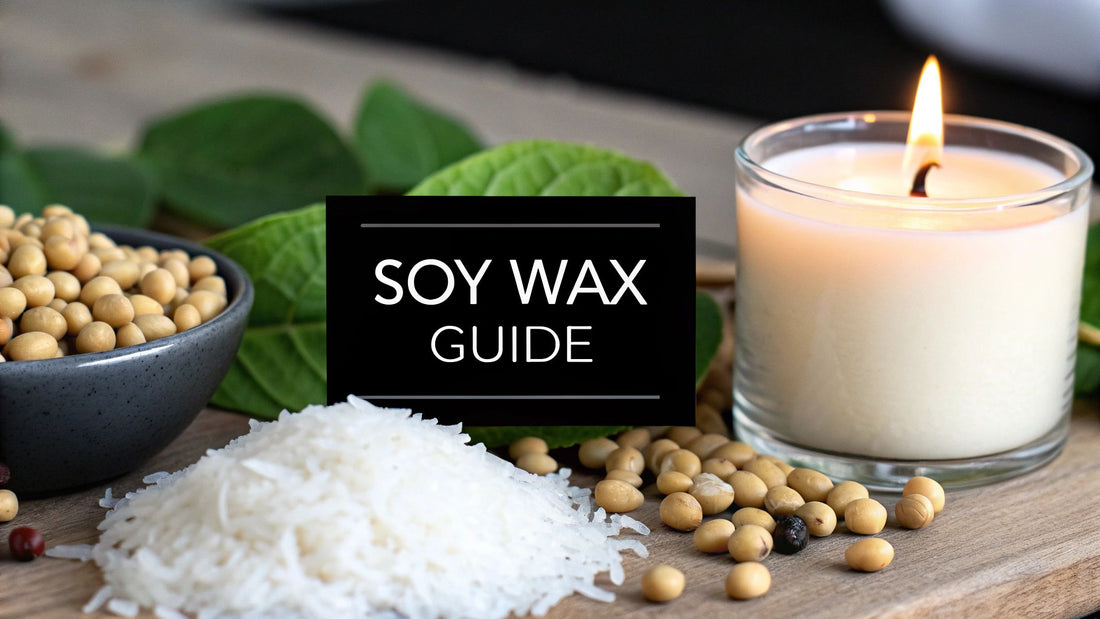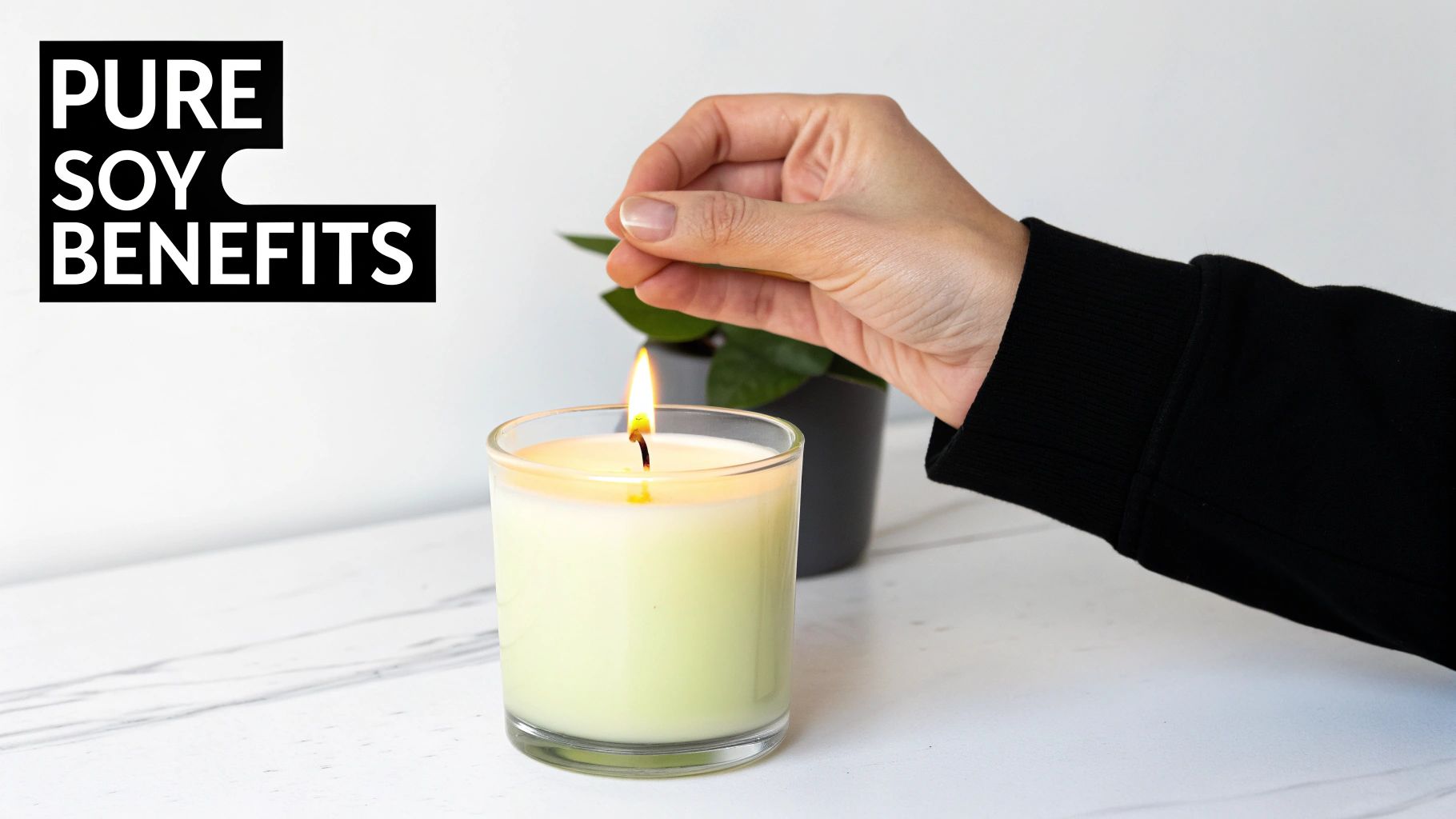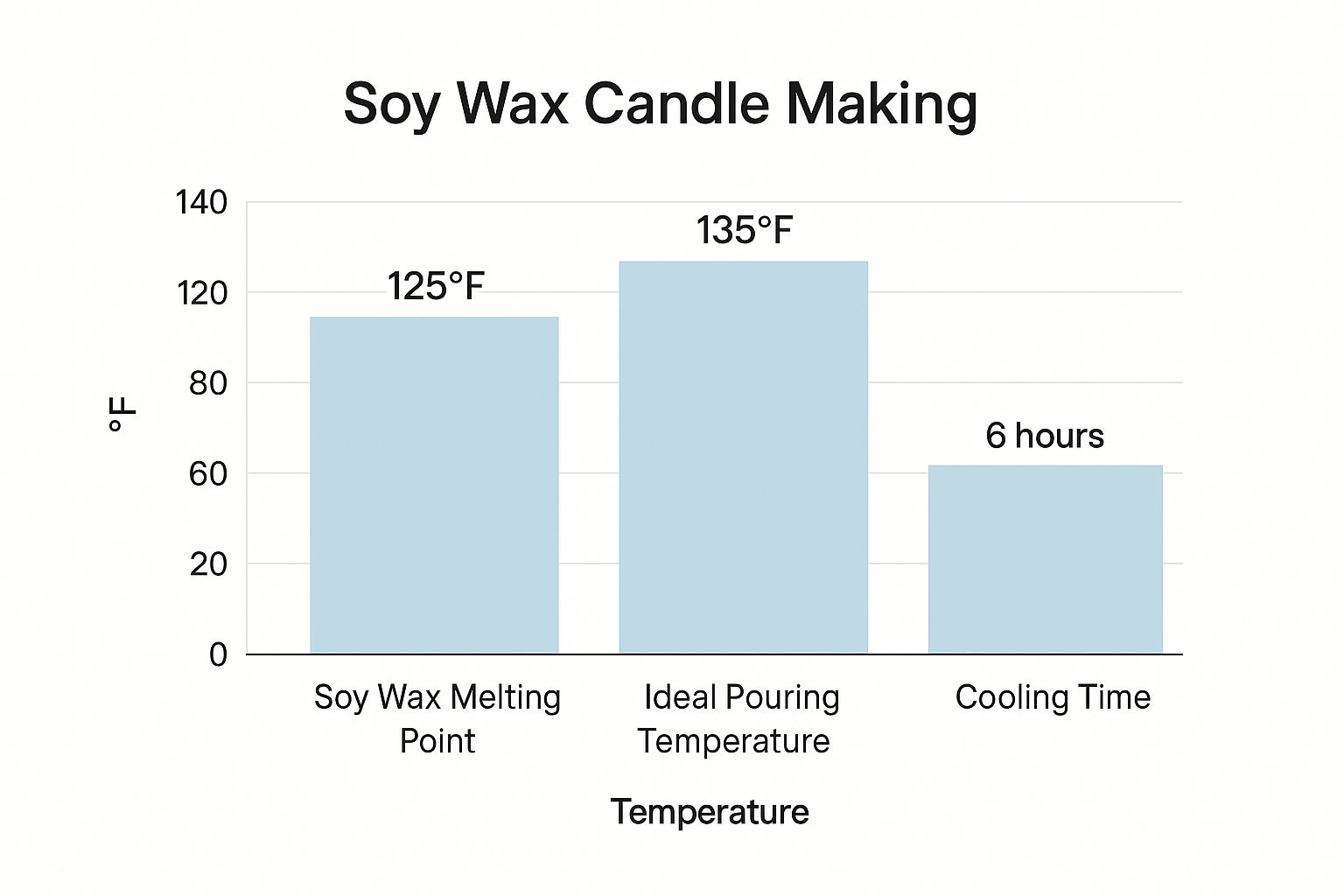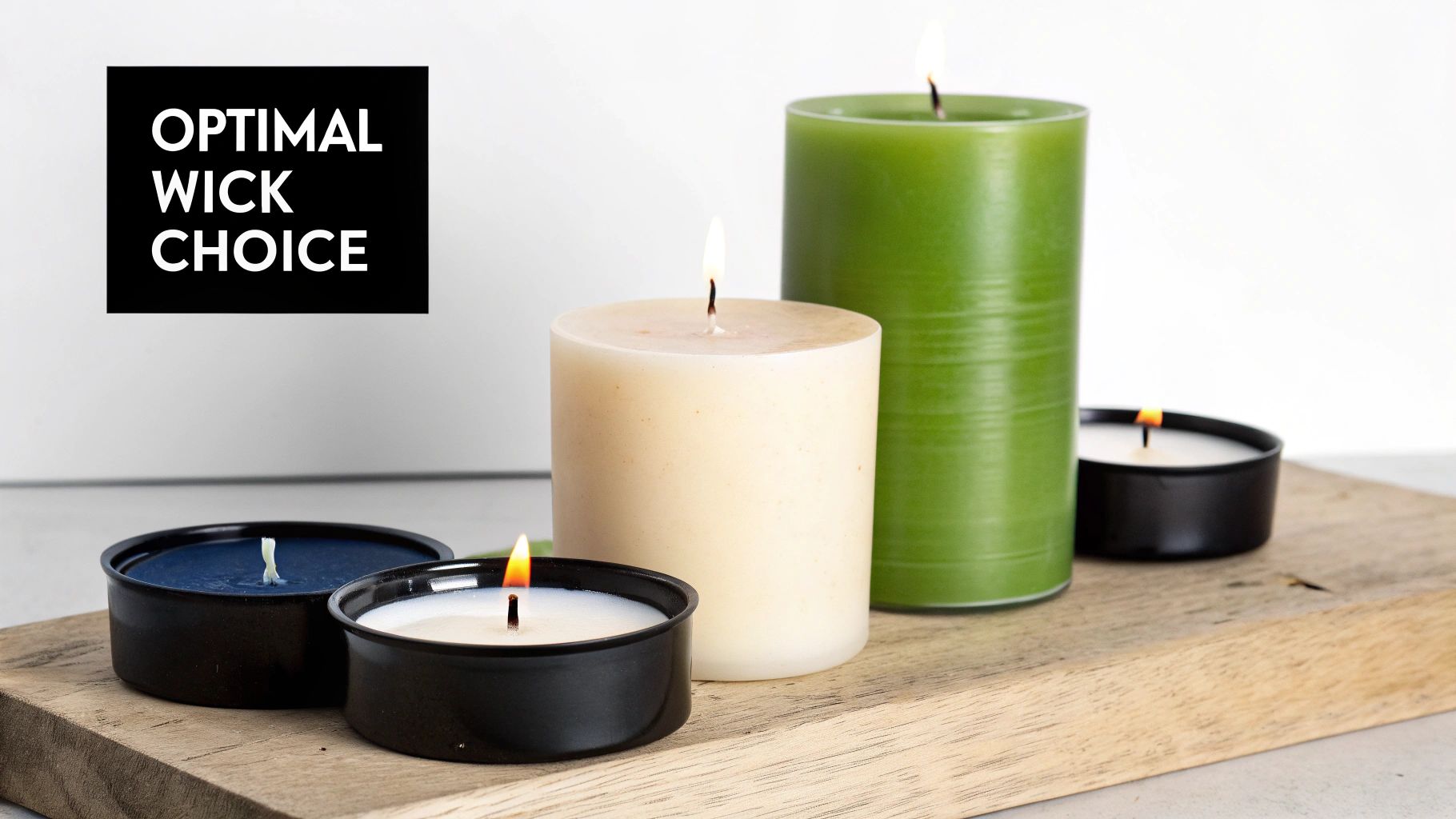
The Ultimate Guide to Soy Wax for Candles
Soy wax is a game-changer in the world of candles. It’s a completely natural, plant-based wax made from soybean oil, and it has quickly become the go-to choice for anyone looking for a premium candle experience—from eco-conscious shoppers to high-end candle artisans.
What really sets it apart is its cleaner burn, longer life, and incredible ability to hold and release beautiful fragrances.
The Journey to Natural Candle Waxes
For a long, long time, candles were made from things like animal fat (tallow). They worked, sure, but they often came with a hefty dose of smoke and unpleasant smells. Then, in the 19th century, paraffin wax hit the scene. As a cheap and reliable byproduct of petroleum, it took over the industry.
But times have changed. Much like we now pay closer attention to the ingredients in our food, we're starting to ask what's actually in the products we bring into our homes. This curiosity has paved the way for fantastic plant-based alternatives, with soy wax leading the charge.
Soy wax offers a sustainable and renewable option that just feels right for a healthier, more environmentally aware lifestyle. This shift in thinking is exactly why so many people are now drawn to the warmth and beauty of natural waxes.
What Really Makes a Candle Wax Stand Out?
When you break it down, a few key qualities separate a great candle wax from a mediocre one. These aren't just technical details for candlemakers; they shape the entire experience for you, from the moment you first light the wick to the very last flicker. Knowing what to look for makes it clear why soy wax has become such a favourite.
Here are the most important performance factors for any candle wax:
-
Burn Quality: A top-tier wax should give you a clean, even burn with barely any soot. This keeps your candle looking pristine and, more importantly, helps maintain better air quality inside your home.
-
Scent Throw: This is the term we use for how well a wax releases its fragrance. You have the "cold throw" (the scent when the candle isn't lit) and the "hot throw" (the aroma that fills the room when it's burning). A strong, beautiful scent is the signature of a high-quality candle.
-
Environmental Impact: Where the wax comes from matters. Waxes made from renewable resources, like soybeans, are a far more sustainable choice than those derived from finite fossil fuels like petroleum.
When you start exploring the many soy wax candle benefits, you quickly see how it excels in every one of these areas. It truly offers a beautiful and responsible way to light up and scent your favourite spaces.
From Soybean to Candle: The Journey of Soy Wax

It all starts in a farmer’s field. The journey of soy wax for candles begins with the humble soybean, a completely renewable resource. Once harvested, the beans are cleaned, cracked, and de-hulled before being rolled into thin flakes. This is where the magic begins.
From these flakes, pure soybean oil is carefully extracted. And the leftover soybean meal? It doesn't go to waste. Instead, it's repurposed as animal feed, making the entire process remarkably sustainable from start to finish. This zero-waste philosophy is a huge reason why so many people are making the switch to soy.
Turning Liquid Oil into Solid Wax
So, how does liquid oil become the solid wax we know and love? The secret is a process called hydrogenation. It might sound a bit scientific, but it’s the same technique used to make margarine from vegetable oil.
Basically, the soybean oil is heated and infused with hydrogen. This simple step alters the oil's chemical makeup, converting some of its unsaturated fats into saturated ones. The result is a higher melting point, which transforms the liquid oil into a soft, creamy wax that’s perfect for making candles. It's also this refined structure that explains the science behind why soy wax burns cleaner than old-school paraffin.
This transformation from a farm-grown bean to a refined wax highlights the natural and biodegradable origins of soy wax. Unlike paraffin, which is a byproduct of petroleum, soy wax comes directly from the earth and can be returned to it.
This shift toward sustainable goods isn't just a niche trend; it's a massive movement. The soy candle market was valued at around USD 500 million in 2026 and is on track to soar past USD 1.2 billion by 2033. That kind of growth sends a clear message: consumers want cleaner, renewable options in their homes.
Different Forms and Blends
Once the wax is created, it’s prepared in different forms to make life easier for candle makers. You'll usually find it sold in a couple of convenient formats.
- Flakes: This is the most common form. The flakes are light, super easy to measure, and they melt down nice and quickly.
- Pellets: Think tiny, bead-like pieces. Pellets are great for mess-free handling and scooping out precise amounts.
You'll also come across soy wax blends. It's often mixed with other natural waxes, like coconut or beeswax, to enhance certain qualities. These blends might create a creamier texture or help the candle throw its scent more effectively, combining the best of both worlds for a truly premium candle.
Comparing Soy Wax To Other Common Waxes
When you’re picking out a candle, the type of wax is a bigger deal than you might think. It’s the heart of the candle, really, affecting everything from how long it burns and how good it smells to its impact on the planet. Getting to know the differences between soy wax and other popular choices like paraffin, beeswax, and coconut wax can help you find a candle that truly fits what you're looking for.
Think of it like choosing a fabric. Cotton is breathable and casual, while silk is luxurious and smooth. Each wax has its own personality and unique traits that make it better for certain kinds of candles and experiences.
Soy Wax vs. Paraffin Wax: The Classic Showdown
Paraffin wax is what most of us grew up with. It's been the go-to for candle makers for ages, mainly because it's cheap to produce. But here's the catch: it's a byproduct of refining crude oil, which makes it a petroleum-based, non-renewable resource. While paraffin is known for throwing a very strong scent, it also tends to burn a little dirtier, leaving behind more soot that can stain your jars and potentially affect your indoor air.
This is where soy wax really shines. It's made from a completely renewable resource—good old soybeans. Soy wax burns much cleaner and slower than paraffin, which means you get a candle that lasts longer and produces hardly any soot. For anyone focused on a healthier home and making a more sustainable choice, soy is almost always the way to go. If you want to get into the nitty-gritty, we have a whole guide on soy wax vs. paraffin wax and why the switch matters.
Soy Wax vs. Beeswax: The Natural Alternatives
Beeswax is another wonderful natural option that’s been used for centuries. Made by honeybees, it has its own light, sweet honey fragrance right out of the gate. It's a very hard wax with a high melting point, which gives beeswax candles an incredibly long burn time.
The downside? That lovely natural scent can sometimes clash with added fragrances, and it's usually the priciest wax you can find. It’s also not a vegan product. Soy wax, being more of a blank canvas, lets intricate fragrance oils come through pure and true. This makes it the top pick for candlemakers who specialize in complex, layered scents. Plus, it's plant-based, vegan-friendly, and much easier on the wallet than beeswax.
Soy Wax vs. Coconut Wax: The Modern Blend
Coconut wax is a relative newcomer, but it's quickly gaining fans for its creamy white appearance, clean burn, and fantastic ability to hold and throw scent. It’s made from coconuts, another sustainable crop. The only real issue is that pure coconut wax is often too soft to stand on its own, especially for pillar candles.
Because of its soft texture, coconut wax is frequently blended with harder waxes—and soy wax is its most common partner. This dream team creates a creamy, long-burning candle that pulls the best from both worlds: the amazing scent throw of coconut and the stability of soy.
To help you see the differences at a glance, here’s a quick comparison of the most common candle waxes.
Soy Wax vs Other Waxes: A Quick Comparison
| Feature | Soy Wax | Paraffin Wax | Beeswax | Coconut Wax |
|---|---|---|---|---|
| Source | Soybeans (renewable) | Crude Oil (non-renewable) | Bees (natural, not vegan) | Coconuts (renewable) |
| Burn Quality | Clean, low soot | Can produce significant soot | Very clean, bright flame | Very clean, low soot |
| Scent Throw | Excellent | Very strong | Can be overpowered by its natural scent | Excellent |
| Cost | Mid-range | Low | High | High (often blended) |
| Eco-Friendly | Yes, biodegradable | No, petroleum-based | Yes, but not vegan | Yes, but often blended |
This table makes it clear why soy wax has become such a favourite. It really hits that sweet spot of performance, sustainability, and value.

This image perfectly illustrates the specific temperatures that make soy wax so unique—from its low melting point to the ideal temperature for pouring. This lower melting point is a key reason why soy candles burn slower and more evenly compared to waxes with higher melt points, like paraffin or beeswax.
In the end, every wax has its place. But for a balance of eco-conscious sourcing, clean performance, and incredible scent delivery, soy wax is a versatile and beloved choice for candle lovers everywhere.
Understanding Scent Performance in Soy Candles

For most of us, the scent is the heart and soul of a candle. It’s what turns a simple flickering light into a full-blown sensory experience, instantly setting the mood or filling a room with a welcoming personality. In the candle world, we talk about this in two ways: cold throw and hot throw.
Think of cold throw as the candle’s first impression—it’s the fragrance you notice when you pick it up in the store or unbox it at home, before it’s even been lit. The hot throw, on the other hand, is the main event. It’s the aroma that fills your space once the wick is burning and a nice, even pool of wax has melted. A truly great soy wax for candles has to nail both.
How Soy Wax Delivers Such a Great Scent
So, what makes soy wax so special when it comes to fragrance? It helps to think of it as a natural sponge. The unique molecular structure of soy wax is brilliant at absorbing and holding onto a large amount of fragrance oil. But the real magic happens when you light the wick.
Soy wax has a lower melting point than traditional paraffin. This means it creates a wider pool of melted wax without needing scorching-hot temperatures. This larger surface area allows the fragrance oils to evaporate more gently and effectively, releasing a cleaner and more authentic scent. Instead of being burned off by intense heat, the aroma is released steadily, revealing all the beautiful, complex notes of the fragrance.
The slow, consistent release of scent is what sets soy wax candles apart. You don't get an overpowering blast of fragrance that quickly disappears. Instead, soy delivers a steady, long-lasting aroma that gracefully fills the entire room.
This reliable performance is a huge reason the scented candle market is booming. In 2022, North America alone accounted for 33% of the industry’s global revenue, and the growing demand for natural, clean-burning candles is a major factor.
Choosing the Best Fragrance for Your Candle
When you’re looking for the perfect scented soy candle, the quality of the fragrance itself is just as crucial as the wax. You’ll generally find two types of oils used, and they create very different experiences.
- Essential Oils: Extracted directly from plants, these offer pure, authentic aromas. They’re often the go-to for aromatherapy because of their natural, therapeutic qualities.
- Fragrance Oils: These are carefully crafted scents, often blended to create complex and imaginative fragrances you can’t get from a single plant—think "Vanilla Bean Noel" or "Ocean Breeze."
Both can make for an incredible candle, but the key is to look for high-quality, phthalate-free oils. If you’re trying to decide what’s right for you, our guide on fragrance oil vs. essential oil breaks it down even further. Knowing a little about both the wax and the oils will help you find a candle that truly smells as good as it looks.
The Benefits of a Cleaner and Longer Burn

Beyond just how well it holds a scent, the real magic of soy wax for candles is how it burns. This is where you’ll notice two massive perks that are better for your home and your wallet: a cleaner burn and a much longer lifespan. It all comes down to the natural properties of soybean oil.
Have you ever noticed that black ring of soot that forms around the rim of some candle jars? That’s a common issue with traditional paraffin candles, which are derived from petroleum. Soy wax, on the other hand, is a hydrogenated vegetable oil that burns incredibly cleanly, leaving behind almost no soot.
This isn’t just about keeping your walls and furniture looking fresh. A cleaner burn means better indoor air quality, which is a big deal for anyone with allergies, asthma, or sensitivities to what's floating around in the air. If you want to dive deeper, we have a complete guide on clean-burning candles for a healthier home.
Enjoying a Slower, More Economical Burn
The second major win is the burn time. Soy wax has a lower melting point than paraffin, which means it doesn't need to get as hot to melt. Think of it like a pat of butter melting slowly in a warm pan versus a harder fat that needs high heat to liquefy.
Because the wax stays cooler, it burns away much more slowly. What does that mean for you? Simple: you get to enjoy your candle for a lot longer.
A standard 8 oz soy candle can burn for up to 50 hours. That's often 30-50% longer than a paraffin candle of the exact same size, making soy a much smarter investment over time.
This slow, gentle burn also helps the fragrance release more evenly, so your candle smells just as amazing on its last burn as it did on its first.
The Simple Cleanup Advantage
Spills happen. But when you’re dealing with soy wax, it’s not a five-alarm fire for your furniture. Thanks to its natural makeup, cleanup is refreshingly easy.
- No Fuss Spill Removal: Forget scraping or using harsh chemicals. A bit of soap and warm water is all you need to clean up a soy wax spill.
- Reusable Jars: Once the candle is done, you can easily wash out the remaining wax. This leaves you with a beautiful jar that's ready to be repurposed for holding pens, planting a small succulent, or storing cotton swabs.
It’s just another way the whole experience of a soy candle—from its creation to its very end—is designed to be more thoughtful and sustainable.
How to Choose High-Quality Soy Wax Candles
https://www.youtube.com/embed/HqlohiRXaKg
Walking into a store or browsing online for candles can feel a bit overwhelming with all the choices out there. But once you know what to look for, you can easily tell a truly well-made candle from one that's just so-so. A few simple checks are all it takes to make sure you're getting a beautiful, clean-burning soy candle.
Look for 100% Soy Wax
First things first, check the label for the wax itself. The gold standard is a candle that’s proudly labelled as 100% soy wax. Some makers create lovely blends, often with coconut or beeswax, and a good brand will always be upfront about what's inside.
If you see a vague term like "soy blend" without any more detail, it's worth being a little cautious. That can sometimes be a way to mask a higher percentage of paraffin wax, which won't give you that clean, long-lasting burn you're looking for.
Check the Wick and Scent Source
Next up, take a look at the wick. Your best bet is always an all-natural cotton or wood wick. These are the perfect partners for soy wax because they burn cleanly and steadily, producing very little soot. It's best to steer clear of wicks that have a metal core, as they can sometimes release particles you don't want floating around your home.
The fragrance is, of course, a huge part of the experience. High-end candles get their beautiful aromas from two main sources: either top-quality, phthalate-free fragrance oils or pure essential oils. Candlemakers who invest in these premium ingredients are usually excited to tell you about them, so this info should be easy to find on the packaging or website.
A great candle is more than just wax and a wick; it's a carefully crafted item. Supporting small businesses and local artisans often leads to discovering products made with exceptional care and ethically sourced materials.
Reading Past the Hype
The candle business is a big one—in the U.S. alone, retail sales top $3 billion each year. With so many brands competing for your attention, it's helpful to know what matters. Here in California, about 65% of those sales are for non-seasonal candles, which shows just how much we love having them in our homes for everyday ambience.
Beyond the wax and wick, people are drawn to beautiful packaging and the wide range of various candle options available. But at the end of the day, a brand you can trust is one that’s transparent about its ingredients and truly stands behind its craft.
Got Questions About Soy Wax Candles? We've Got Answers
Diving into the world of soy wax candles often brings up a few questions. That's completely normal! Getting these common queries sorted out will help you feel great about bringing a natural, clean-burning candle into your home.
"Is Soy Wax Really 100% Natural?"
One of the first things people ask is if soy wax is truly "all-natural." The answer is a definite yes. It comes straight from soybeans, a crop that can be grown again and again, making it a fully plant-based and biodegradable option. This is what really sets it apart from paraffin wax, which starts its life as a byproduct of petroleum.
"Why Does My Soy Candle Look a Bit... Different?"
You might have noticed that soy candles can have their own unique look. Sometimes you'll see a light, crystalline pattern on the surface (we call that "frosting"), or maybe you'll spot places where the wax has pulled away from the side of the jar.
Don't worry – these aren't flaws! They're actually signs that you're holding a candle made from 100% natural soy wax. These little quirks are part of its charm and have absolutely no effect on how the candle burns. Think of them as proof that your candle isn't full of the synthetic additives paraffin waxes need to look artificially perfect.
Is soy wax safe to burn around pets? Generally, yes. Plain, unscented soy wax is non-toxic. The real consideration is the fragrance itself. Some essential or fragrance oils can be a bit much for sensitive animal noses, so it's always smart to light your candle in a well-ventilated room and, of course, keep it well out of your pet's reach.
"Do Soy Candles Smell as Strong as Paraffin Ones?"
Finally, there's the big question about scent. Do soy candles pack the same punch as paraffin? While paraffin can give you a powerful blast of fragrance right at the start, soy wax plays a longer, more sophisticated game.
Because soy wax has a lower melting point, it releases its fragrance more slowly and steadily. This creates a beautifully consistent aroma that gently fills a room without ever feeling overwhelming. You get to enjoy a pleasant, lasting scent from the very first light right down to the bottom of the jar.
At Shivora Candles, we're all about celebrating the natural beauty and incredible performance of 100% soy wax. Come explore our collection of clean-burning, exquisitely scented candles and find the perfect fragrance to elevate your home at https://shivoracandles.com.
